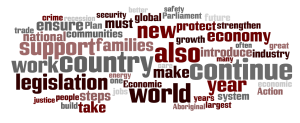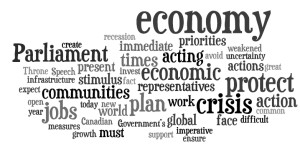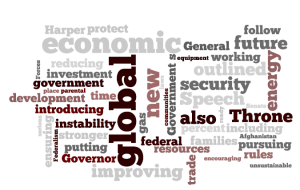Technology gives us gimmicks and toys but it also gives us interesting tools. Where does the Word Cloud — a process that reduces a series of text into a picture based on word frequency — come in? The images are simply cool. Don’t be fooled though… sometimes cool is also filled with insight.
Consider the following word cloud produced using the application at wordle.net. It is the top 50 words used in the 2010 “Speech from the Throne” (SFT) with a couple of words removed. The words removed were Canada (and its other derivatives) and government.
The top words are continue, country, support, world. This is not a “Speech from the Throne” that appears to have a strong agenda. Notably, the CBC on its webpage actually produced a similar looking CBC Wordle. There were approximately 6,000 words in the speech that was supposed to recalibrate the Government’s agenda.
Contrast the 2010 speech with the one from 2009. Here we have a speech that clearly has a strong almost forceful purpose. The speech was short (738 words) and the economy is dominant. Other prominent words also convey a sense of direction — crisis, protect, plan, acting, action.
Two and a half months earlier, the 2008 SFT was less focused and broader (it was also short, 525 words). While the economy and the global crisis were clearly on the horizon for the Government, there was a diffuse set of other issues discussed. In fact, clearly negative words (e.g. instability) were balanced often with positive words (improving).
The Harper government provided two speeches that were broad and somewhat diffuse in their agenda that bookended a forceful economic driven speech. Although a reader of the three speeches would no doubt some to a similiar conclusions, the word cloud lets us offer a graphic representation.
It is inexpensive … wurdle.net lets you create these images for free, and can be an excellent heuristic device. Tone is, of course, missing and context is stripped away. This means that the word cloud approach is really only valuable when one is looking at a set of text that has a clear perspective… even without reading the SFT we can identify what Harper might mean with different words.
It is thus best used when all of the comments are from a single source (e.g. a speech) or from a clear open-ended question “What do you like most about x?” rather than questions that are too general.
The word cloud rests somewhat uncomfortably between qualitative analysis and text analytics, which tend to adopt a more comprehensive approach to quantifying the analysis of text. Is it here to stay or will readers tire of the gimmick as it starts to make its regular appearance in reports, presentations and commentary?



